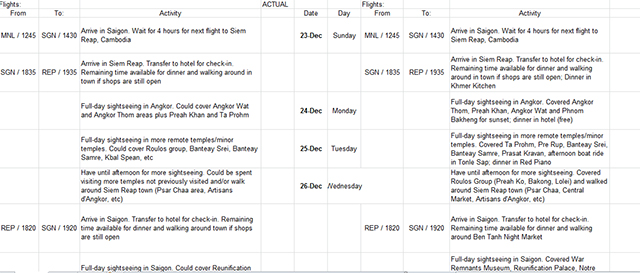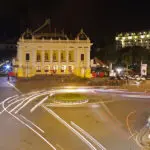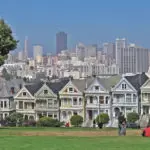It used to be the case that I would prepare an itinerary every single time I went for a trip. Thanks to Excel, I would diligently put in the dates, places and the things that I would be doing by the hour. It was quite handy (not to mention overkill), especially for my travel buddies who would always ask to see an itinerary prior to our departure.
When I started blogging, it soon dawned on me how important itineraries were to most people. I have received countless emails asking me to send itineraries for this place and that. There were even times I received requests for itineraries on places I’ve never written about in I Wander! I’ve been happy to oblige whenever I could. But because of the sheer amount of requests, and thinking that it would make my articles more user friendly, I started including itineraries in my entries.
 traveling is a bit like watching movies – the more advance peeks you have, the less exciting the movie becomes when you actually get to see it
traveling is a bit like watching movies – the more advance peeks you have, the less exciting the movie becomes when you actually get to see it
Photo by Raymond Shobe in Flickr | CC 2.0
Frankly speaking, I don’t use itineraries anymore whenever I travel and I haven’t been doing so for probably the last 3 years. When my friends go for a trip to the same places I’ve been to recently and ask me for one, I usually have nothing to show them.
I’ve not enjoyed my trips as much as when I started ditching my itineraries. While these sheets of paper may make the trip more organized (especially if the objective is to tick a checklist of sights), basing one’s schedule on an itinerary can sometimes feel, for the lack of a better term, robotic. There are certain merits to leaving itineraries behind the next time you travel. These are just some of them:
Itineraries can be stifling
Having a detailed itinerary can be stifling to the overall experience. Itineraries are often used to define schedules, locations, sights and perhaps activities instead of relaxation, interaction with locals or the pursuit of wonderful opportunities that spontaneously pop up (and they often do). Traveling shouldn’t be about following a checklist. You’ve already had enough of that doing groceries and working!
It allows you to focus on your main objective – TRAVELING

You travel because you want to see things and experience the sights and sounds – to get a good sense of what the place is really about. Itineraries tend to desensitize the whole thing and lead you somewhere regardless of whether it has any personal meaning to you just because “it’s in the itinerary.” A fundamental problem of the usage of itineraries is that you can’t just stamp an X number of days to a place you’ve never been before!
How many times have you gone to a place wishing you’d stayed longer, or at the other extreme, find a city to be a total dump and wished you’d never came?
Not having an itinerary gives you freedom. Freedom to pursue whatever it is that urged you to fly somewhere 2,000 miles away. Freedom to spend several days in a random town not even mentioned in the guidebook because it appeals to you. Freedom. Period.
Traveling is not a race!
One of the main objections of those who live by itineraries is that it allows them to see as many places as possible. But isn’t that one of the greatest contradictions of traveling? I mean, we go out on a journey to escape the rat race and the pressures of every day life, and not to be sucked into another such trap. Ultimately, I think a better measurement of a trip is whether you enjoyed every single moment, rather than by how many UNESCO World Heritage Sites or countries you’ve visited!
You gain more “life skills”
A sure fire way to gain more life skills while on the road is to go without an itinerary. This will definitely test your wits, especially when you venture somewhere you don’t know the language. You’ll be proud of yourself when you emerge unscathed in the end. It’s also a good confidence builder. Trust me.
You wouldn’t want to have the exact duplicate of another person’s experience
Probably the biggest disadvantage of having an itinerary – especially those picked up from friends / online / travel agencies – is that the trip is an exact duplicate of what thousands of others who went on a package tour / media junket have done. Not everyone has the time or privilege to go traveling. Use it to do the things you want instead of enslaving yourself to another person’s experience.
Tips on getting the trip together without using an itinerary:
- Find out more about the destination/s you’re intending to visit. Guidebooks and the world wide web are your best bets! You already have the interest for a start (isn’t that why you choose to go there in the first place?) That should be enough reason to get you reading – to enable you to decide for yourself which sights are worth visiting, which places are worth dining at and how far your budget can take you.
- You don’t need to find out about all plane, train, bus routes or search for the absolute best hotel/hostel out there. Believe it or not, a general knowledge about the place is more than enough. You’ll be able to figure out the rest once you’re there.
- It’s useful to talk to friends and contacts who have been there to get more information, and you may even get more ideas by checking out their contacts and *cough* itineraries.
- Going somewhere without making any prior plans is not always a bad thing. In a way, it serves to heighten the overall travel experience. It’s not too different from watching spoilers before seeing the film in its entirety. The more you get to see beforehand, the less exciting / thrilling / scary / funny the movie becomes when you actually get to see it. Same with traveling.
What are your thoughts about itineraries? Take them or leave them?






Great article! I made a detailed day-by-day itinerary the first time I travelled solo to Mexico City. After the first day I made some new friends and that itinerary went out the window!! It’s nice on shorter trips to plan a bit if you have to make reservations etc. but on longer trips a wing-it approach is definitely the most fun. 🙂 Happy travels.
Nice read. I normally do itineraries to serve as a guide where I wanted to go in each place, especially if I’ll be in different places in one trip. It wouldn’t have specific days of when I’ll be going to each, just group the places which are near each other. Then, during my trip, I would just decide which will be my activity, and which can be passed depending on the time. I just make sure that I fulfill the main purpose of my trip (e.g. going to a festival on a specific day), if there’s any. Well, I guess my itinerary is really just like an overview of my trip… the days I’ll be spending on each place (I normally do advance booking on accommodation as these are sometimes cheaper when booked ahead of time) and the places/things I want to go to.
If I’m staying in one place which I’ve been to before, I don’t do this anymore. I think it’s easier and less stressful to just go where your feet takes you. 🙂
This is how I see itineraries- Whatever floats your boat. Some people, especially who are geographically-challenged, are more comfortable with a set itinerary because it gives them a sense of direction for the rest of the trip. The risk-takers are more spontaneous since they know that they can take care of themselves even if lost in the middle of nowhere. And there are some who would like to find the balance in being both a tourist and a traveller. I think knowing the places to go to, knowing the transport situation in certain places, booking the hotel in advance are some of the basic and important things to take care of to make the trip more efficient and stress-free. The essence of travelling is getting lost in the moment and finding yourself/who you are through the experiences and having the basics down will create more opportunities to enjoy what the trip has to offer. As far as putting time frames on each activity, that doesn’t appeal to me because, I agree with you, that it takes away the thrill of feeling that freedom that comes with explorations. One needs to be flexible and can go with the flow from time to time.